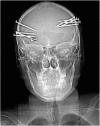Ten self-inflicted intracranial penetrating nail gun injuries
- PMID: 26166596
- PMCID: PMC4710333
- DOI: 10.17712/nsj.2015.3.20150088
Ten self-inflicted intracranial penetrating nail gun injuries
Abstract
Penetrating craniocerebral injuries from nail gun use are rare. We describe a case of 10 self-inflicted nail gun injuries with intracranial penetrations. We also review the literature and discuss management strategies of such craniocerebral trauma. A 33-year-old male with a long-standing history of severe depression took a nail gun and sustained 10 penetrating intracranial injuries. Initial neuroimaging revealed 10 penetrating nails, all sparing the major cerebral vasculature. Immediate surgical removal was undertaken in the surgical suite using a combination of craniotomies, craniectomies, and blind removal. Intracranial injuries from self-inflicted nail gun misuse is becoming increasingly more frequent. Initial appropriate clinical decision-making are critical in preventing further cortical or vascular damage.
Figures
Similar articles
-
Self-inflicted nail-gun injury with 12 cranial penetrations and associated cerebral trauma. Case report and review of the literature.J Neurosurg. 2006 May;104(5):828-34. doi: 10.3171/jns.2006.104.5.828. J Neurosurg. 2006. PMID: 16703892 Review.
-
Multiple self-inflicted nail gun head injury.South Med J. 2007 Jun;100(6):608-10. doi: 10.1097/SMJ.0b013e3180398e47. South Med J. 2007. PMID: 17591316
-
Nail gun injuries to the head with minimal neurological consequences: a case series.J Med Case Rep. 2016 Mar 16;10:58. doi: 10.1186/s13256-016-0839-1. J Med Case Rep. 2016. PMID: 27080512 Free PMC article. Review.
-
External Ventricular Drainage Preceding the Removal of a Nail from the Intracranial Space as a Safe Management Strategy for Predicted Secondary Intraventricular Hemorrhage.World Neurosurg. 2017 Oct;106:1056.e9-1056.e13. doi: 10.1016/j.wneu.2017.07.104. Epub 2017 Jul 26. World Neurosurg. 2017. PMID: 28755920
-
Penetrating craniocerebral injuries from nail-gun use.J Clin Neurosci. 2007 Jul;14(7):678-83. doi: 10.1016/j.jocn.2006.02.017. Epub 2007 Apr 23. J Clin Neurosci. 2007. PMID: 17452105
Cited by
-
Self-inflicted bilateral penetrating brain injury with a nail gun in an African American male: illustrative case.J Neurosurg Case Lessons. 2025 Feb 10;9(6):CASE24520. doi: 10.3171/CASE24520. Print 2025 Feb 10. J Neurosurg Case Lessons. 2025. PMID: 39928930 Free PMC article.
-
Management outcome of a patient with a self-inflicted multiple intracranial nail impalement in a tertiary hospital in Uyo: illustrative case.J Neurosurg Case Lessons. 2025 Jun 16;9(24):CASE25103. doi: 10.3171/CASE25103. Print 2025 Jun 16. J Neurosurg Case Lessons. 2025. PMID: 40523352 Free PMC article.
-
Repetitive Self-Inflicted Craniocerebral Injury in a Patient with Antisocial Personality Disorder.Diagnostics (Basel). 2024 Jul 18;14(14):1549. doi: 10.3390/diagnostics14141549. Diagnostics (Basel). 2024. PMID: 39061686 Free PMC article.
-
Thirty-two nails injected into the head: An operative report and review of the literature.Surg Neurol Int. 2022 Aug 26;13:377. doi: 10.25259/SNI_512_2022. eCollection 2022. Surg Neurol Int. 2022. PMID: 36128153 Free PMC article.
References
-
- Centers for Disease Control and Prevention (CDC) Nail-gun injuries treated in emergency departments--United States, 2001-2005. MMWR Morb Mortal Wkly Rep. 2007;56:329–332. - PubMed
-
- Hiraishi T, Kawaguchi T, Kobayashi T, Tomikawa M, Ito Y, Fujii Y. Unstable stenosis of the internal carotid artery caused by a craniofacial nail-gun injury-case report. Neurol Med Chir (Tokyo) 2009;49:590–593. - PubMed
-
- Beaver AC, Cheatham ML. Life-threatening nail gun injuries. Am Surg. 1999;65:1113–1116. - PubMed
-
- Tancioni F, Gaetani P, Pugliese R, Rodriguezy Baena R. Intracranial nail. A case report. J Neurosurg Sci. 1994;38:239–243. - PubMed
-
- Holmes B, Harbaugh RE. Traumatic intracranial aneurysms: a contemporary review. J Trauma. 1993;35:855–860. - PubMed
Publication types
MeSH terms
LinkOut - more resources
Full Text Sources
Other Literature Sources
Medical




